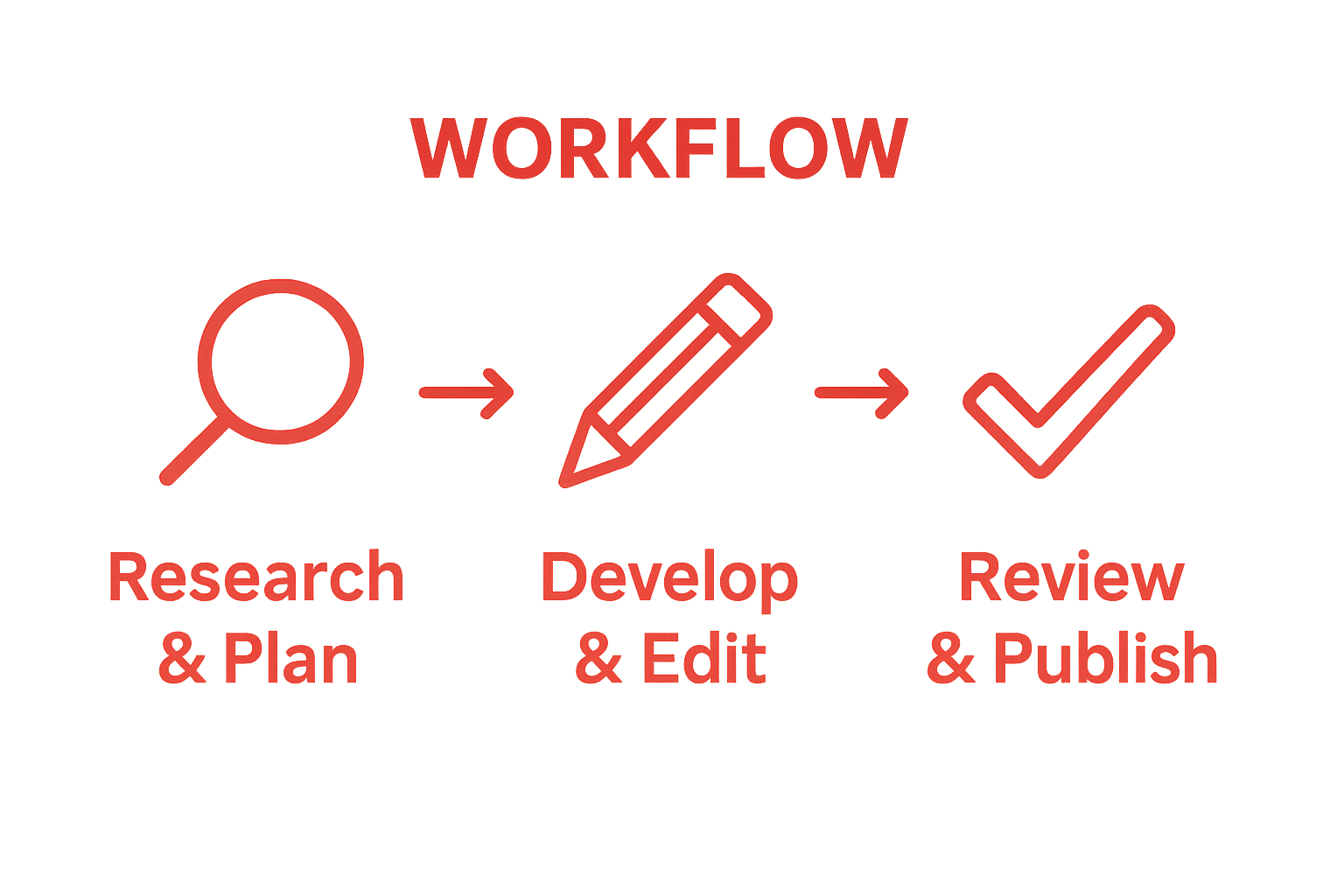Understanding the Website Content Creation Workflow
Every business wants their website to stand out, but creating content is rarely as simple as it seems. Teams without a well-defined workflow waste up to 30 percent more time producing digital content. You might think the trick is just writing good copy or adding fancy graphics. Actually, the real secret is creating a clear, repeatable process behind the scenes. That is where the magic happens and why most websites never hit their full potential.
Table of Contents
- What Is A Website Content Creation Workflow?
- Why Is The Website Content Creation Workflow Important?
- Key Components Of The Website Content Creation Workflow
- How The Website Content Creation Workflow Enhances Content Quality
- Real-World Applications Of The Website Content Creation Workflow
Quick Summary
| Takeaway | Explanation |
|---|---|
| Establish a structured content workflow | A systematic workflow coordinates the process from ideation to publication, ensuring clarity and direction for the team. |
| Enhance quality through rigorous review | Implement multi-stage review processes to maintain high standards and prevent errors, ensuring consistent brand messaging. |
| Focus on strategic planning and research | Understanding audience needs and aligning content with organisational objectives are crucial for effective content creation. |
| Use data for continuous improvement | Tracking performance metrics allows for informed decisions, refining content quality and engagement over time. |
| Adapt workflows to organisational needs | Tailor content processes to specific industries or organisational contexts for optimal effectiveness and efficiency. |
What is a Website Content Creation Workflow?
A website content creation workflow represents a systematic process that guides the strategic development, production, and management of digital content from initial concept to final publication. Unlike random content generation, this workflow provides structure, consistency, and purposeful direction to content creation efforts.
Understanding the Core Components
At its fundamental level, a website content creation workflow encompasses several interconnected stages that transform raw ideas into polished, professional digital content. These stages typically involve collaboration, strategic planning, and precise execution.
The workflow fundamentally serves as a roadmap that coordinates multiple team members and their respective responsibilities. Whether you are working with writers, designers, editors, or subject matter experts, the workflow ensures everyone understands their role and the expected deliverables.
The Strategic Purpose of Content Workflows
Content workflows are not merely administrative tools but strategic frameworks that help organisations achieve specific communication objectives. By exploring our content creation services, businesses can understand how structured approaches enhance content quality and efficiency.
Key strategic benefits of a well-designed content workflow include:
- Maintaining consistent content quality across different projects
- Reducing miscommunication between team members
- Establishing clear accountability for each production stage
- Enabling predictable content timelines and deliverables
- Facilitating easier performance tracking and continuous improvement
Content workflows transform chaotic content production into a streamlined, predictable process. They act as blueprints that guide teams from initial brainstorming through research, drafting, editing, and final publication, ensuring that every piece of content meets predetermined standards of excellence.
The following table compares the key strategic benefits of implementing a well-defined website content creation workflow, clarifying how each benefit contributes to organisational efficiency and success.
| Strategic Benefit | Explanation |
|---|---|
| Consistent Content Quality | Maintains high standards across all projects and outputs |
| Reduced Miscommunication | Minimises errors and misunderstandings between team members |
| Clear Accountability | Assigns ownership and responsibility for each stage of content production |
| Predictable Timelines and Deliverables | Enables accurate planning and delivery of content |
| Easier Performance Tracking | Facilitates measurement and continuous improvement of content effectiveness |
Ultimately, a robust website content creation workflow is about creating a repeatable system that produces high-quality, purposeful content while minimising inefficiencies and maximising team collaboration.
Why is the Website Content Creation Workflow Important?
Website content creation workflows are critical strategic tools that transform content production from a haphazard process into a systematic, purposeful endeavour. These workflows are not mere administrative checklists but sophisticated mechanisms that drive organisational efficiency, quality control, and strategic communication.
Strategic Value and Operational Efficiency
A robust content creation workflow provides substantial strategic advantages by aligning content production with broader business objectives. Systematic workflows enable organisations to create consistent, high-quality digital content that effectively communicates their message, engages target audiences, and supports overall marketing and communication strategies.
By standardising content development processes, businesses can significantly reduce time wastage, minimise errors, and create predictable production timelines. This approach allows teams to focus on creativity and strategic thinking rather than getting bogged down in administrative complexities.
Quality Control and Brand Consistency
Content workflows serve as critical quality assurance mechanisms. Learn more about our digital content creation approach to understand how structured processes maintain brand integrity.
Key quality control benefits include:
- Ensuring all content meets predefined standards
- Maintaining consistent brand voice and messaging
- Implementing thorough review and editing processes
- Tracking content performance and continuous improvement
- Reducing potential miscommunication and errors
According to the Australian National Audit Office, effective website management requires clear procedures and systematic content development approaches that support organisational communication objectives.
Ultimately, website content creation workflows are not optional luxuries but essential frameworks that enable businesses to communicate effectively, maintain professional standards, and adapt quickly to changing digital communication landscapes. They represent a strategic investment in organisational communication capabilities, transforming content from a random output into a powerful, purposeful tool for engagement and brand storytelling.
Key Components of the Website Content Creation Workflow
A website content creation workflow comprises intricate, interconnected components that transform raw ideas into polished digital content. Understanding these components is crucial for organisations seeking to develop systematic, efficient content production processes.

Strategic Planning and Content Research
Strategic planning forms the foundational element of any effective content creation workflow. This initial stage involves comprehensive research, audience analysis, and alignment with organisational communication objectives. Teams must invest significant effort in understanding target audience needs, market trends, and specific content requirements.
Key research activities include:
- Conducting audience persona development
- Performing competitive content analysis
- Identifying content gaps and opportunities
- Establishing clear content objectives
- Mapping content to user journey stages
Content Development and Collaboration Processes
Content development represents the core execution phase of the workflow. Explore our digital content creation services to understand how professional teams manage this complex process.
According to the Digital Profession’s content workflow guidelines, successful content development requires clear role definition, collaborative mechanisms, and structured review processes.
Quality Assurance and Performance Evaluation
The final critical component involves rigorous quality assurance and continuous performance monitoring. This stage ensures content meets predefined standards, aligns with brand guidelines, and delivers measurable value to the target audience.
Essential quality assurance activities include:

- Implementing comprehensive editorial reviews
- Checking content for accuracy and relevance
- Verifying alignment with brand voice
- Conducting SEO and readability assessments
- Tracking content performance metrics
By understanding and implementing these key components, organisations can transform their content creation from a random process into a strategic, repeatable system that consistently produces high-quality, purposeful digital content.
The table below summarises the core components of a website content creation workflow, providing a concise overview of each element and its primary function in the process.
| Component | Purpose |
|---|---|
| Strategic Planning and Content Research | Lays the foundation through research, audience analysis, and alignment with organisational objectives |
| Content Development and Collaboration | Executes the content plan with collaboration, drafting, and coordination among team members |
| Quality Assurance and Performance Evaluation | Ensures standards are met by reviewing, editing, and tracking content effectiveness |
How the Website Content Creation Workflow Enhances Content Quality
A structured website content creation workflow acts as a sophisticated quality enhancement mechanism, transforming content from basic information delivery to strategic communication tools. By implementing systematic processes, organisations can significantly elevate their digital content’s effectiveness, relevance, and impact.
Systematic Quality Control Mechanisms
Quality control represents the fundamental cornerstone of an effective content creation workflow. This approach goes beyond traditional editing processes, embedding quality checks throughout the entire content development lifecycle. By establishing clear standards and review checkpoints, teams can consistently produce content that meets predefined excellence criteria.
Key quality enhancement strategies include:
- Implementing multi-stage review processes
- Creating comprehensive content guidelines
- Establishing clear editorial standards
- Developing systematic feedback mechanisms
- Ensuring consistent brand voice alignment
Precision and Consistency in Content Development
Explore our digital content creation approach to understand how structured workflows maintain exceptional content standards. Content workflows provide a framework that reduces variability and eliminates inconsistencies across different content pieces.
According to the Australian Government’s Style Manual, understanding user needs is crucial in creating high-quality, targeted content that resonates with the intended audience.
Continuous Improvement and Performance Tracking
A robust content creation workflow enables continuous performance monitoring and iterative improvements. By tracking content metrics, organisations can make data-driven decisions that progressively enhance content quality.
Essential performance tracking elements include:
- Analyzing user engagement metrics
- Monitoring content reach and impact
- Identifying areas for content refinement
- Comparing performance against benchmarks
- Implementing regular content audits
Ultimately, a well-designed content creation workflow transforms content production from a random process into a strategic, quality-driven approach that consistently delivers valuable, precise, and impactful digital communication.
Real-World Applications of the Website Content Creation Workflow
Website content creation workflows transcend theoretical concepts, delivering tangible benefits across diverse organisational contexts. Practical implementation demonstrates how structured processes transform content development from a reactive task into a strategic organisational capability.
Scaling Content Production for Complex Organisations
Large organisations require sophisticated content workflows to manage multiple content streams efficiently. These workflows enable teams to coordinate complex content production processes, ensuring consistency and quality across different departments, platforms, and communication channels.
Key scaling considerations include:
- Managing content for multiple business units
- Maintaining consistent brand messaging
- Coordinating cross-functional content teams
- Implementing centralised content governance
- Developing adaptable content production frameworks
Digital Transformation and Content Strategy
Explore our website project case studies to understand how professional workflows drive digital transformation. Content creation workflows play a critical role in organisational digital strategy, enabling businesses to adapt quickly to changing digital communication landscapes.
According to the Digital Profession’s workflow guidelines, successful digital transformation requires structured, repeatable content production processes that align with broader organisational objectives.
Industry-Specific Content Workflow Applications
Different industries implement content workflows uniquely, tailoring processes to their specific communication requirements. From educational institutions developing learning materials to government agencies producing public information, content workflows provide a systematic approach to content development.
Industry-specific workflow adaptations include:
- Healthcare organisations creating patient information resources
- Educational institutions developing online learning content
- Government agencies producing public communication materials
- Technology companies generating technical documentation
- Non-profit organisations creating impact reporting content
Ultimately, website content creation workflows represent more than administrative tools. They are strategic frameworks that enable organisations to communicate effectively, maintain professional standards, and adapt swiftly to evolving digital communication requirements.
Transform Your Content Challenges Into Strategic Success
Is your organisation struggling to maintain quality and consistency in your digital content? Are you finding it difficult to streamline collaboration and deliver purposeful content that truly resonates? The article has shown how a website content creation workflow minimises inefficiencies and ensures every stage—from planning to publication—works toward your business goals. You do not need to let complexity and inconsistency hold your mission back.

Take the next step to structured and effective content creation. Partner with a team who understands how to build sustainable websites and implement strategic processes for lasting impact. Visit Marzipan to explore how our solutions can help you put these best practices in action. Discover how our content creation services and digital content creation approach can deliver clarity, efficiency and real results for your mission-led business. Secure your competitive edge by refining your content workflow today.
Frequently Asked Questions
What is a website content creation workflow?
A website content creation workflow is a systematic process that guides the development, production, and management of digital content from initial concept to final publication, providing structure and consistency to content generation.
Why is a content creation workflow important?
A content creation workflow is important because it aligns content production with business objectives, enhances organisational efficiency, ensures quality control, and maintains brand consistency, ultimately improving strategic communication.
What are the core components of a website content creation workflow?
The core components include strategic planning and content research, content development and collaboration processes, and quality assurance and performance evaluation to ensure every piece of content meets predetermined standards.
How does a content workflow improve content quality?
A content workflow improves quality through systematic quality control mechanisms, reduced variability in content development, clear editorial standards, and continuous performance tracking, enabling organisations to develop high-quality and impactful digital content.
Recommended
- Static Content Creation | Blogs, Copywriting & Design | Marzipan Media
- Digital Content Creation | Social Media Video & Visual Storytelling | Marzipan Media
- Blog – Marzipan Digital | Marzipan Media
- Blog – Marzipan Digital | Marzipan Media







